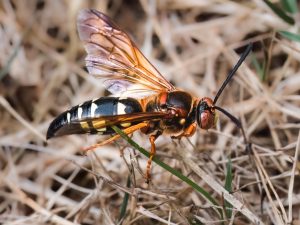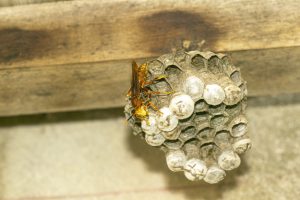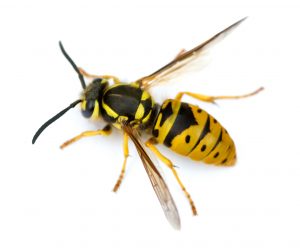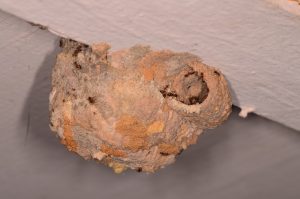How to Identify Wasp Nests
Wasps are resourceful builders, creating nests in various locations that can bring them alarmingly close to human activity. They often find cracks in your home, sheltered areas like wall voids, hollow trees, or underground spaces to establish their nests.
At first glance, you might mistake wasps for hornets due to their similar appearance. Although their nests differ, the two species share many visual similarities. Discover the differences between wasps and hornets.
It’s important not to aggravate a wasps nest by trying to remove it yourself. If you spot a wasp nest in your space, professional intervention is necessary. Learn more about the dangers of wasps.
Most Common Types of Wasp Nest
In Georgia, the most common types of wasp nests are built by cicada killer wasps, paper wasps, yellowjackets, and mud daubers. These nests vary in appearance, location, and material, making understanding their key features crucial for proper identification.
Cicada Killer Wasp Nests
 Cicada killers prefer to nest underground. Their nests are burrowed into loose soil and marked by mounds of dirt with a single entry hole. These nests are simple burrows in the ground, marked by soil mounds with an entrance hole.
Cicada killers prefer to nest underground. Their nests are burrowed into loose soil and marked by mounds of dirt with a single entry hole. These nests are simple burrows in the ground, marked by soil mounds with an entrance hole.
Though large and intimidating, these wasps are not typically aggressive.
Paper Wasp Nests
 Paper wasp nests are small, umbrella-shaped structures made from a paper-like material and are made from chewed wood fibers and often attached to eaves or branches.
Paper wasp nests are small, umbrella-shaped structures made from a paper-like material and are made from chewed wood fibers and often attached to eaves or branches.
These nests are often attached to sheltered areas, such as eaves, rafters, or tree branches. Paper Wasps are moderately aggressive when their nests are disturbed.
Yellowjacket Nests
 Yellowjackets create intricate, paper-like nests that can be found above ground and underground. These can vary in appearance but are typically made from a gray, paper-like material. They may be hidden underground, in walls, or hanging from structures.
Yellowjackets create intricate, paper-like nests that can be found above ground and underground. These can vary in appearance but are typically made from a gray, paper-like material. They may be hidden underground, in walls, or hanging from structures.
Common locations include wall voids, tree cavities, and even abandoned rodent burrows. These nests are densely populated and home to highly aggressive colonies.
Mud Dauber Nests
 Mud daubers construct unique tube-shaped nests made of mud, often clustered together in sheltered spaces.
Mud daubers construct unique tube-shaped nests made of mud, often clustered together in sheltered spaces.
These are commonly found on walls, ceilings, or sheltered areas such as garages or sheds. Mud daubers are solitary and less aggressive than other wasp species.
Preventing wasps from settling in your yard or outdoor space is crucial for maintaining a safe and comfortable environment. Discover ways to keep wasps away (and avoid stings!).
Where Are Wasp Nests Found?
Different species of wasps favor specific nesting locations, which vary based on their habits and the surrounding environment. Common locations for wasp nests include:
- Wall Voids: Yellowjackets often nest in cracks, gaps, and cavities within walls or attics.
- Sheltered Areas: Paper wasps attach their nests under eaves, sheds, or tree branches.
- Hollow Trees: Cicada killer wasps and other species may use natural cavities in trees for their nests.
- Underground: Yellowjackets and cicada killer wasps frequently burrow into the soil to create ground nests.
Wasp nests can also be found in unexpected places around your property, so it’s important to remain vigilant.
Our wasp nest experts can help you identify your species based on their nest and recommend the most effective removal treatment. Discover more about our nest removal services today!
Need Help With Wasp Nest Removal?
If you’ve found a wasp nest on your property, it’s important to take action quickly and safely. At Active Pest Control, we specialize in identifying and removing wasp nests to protect your family and home.
Our trained professionals will carefully handle the situation, ensuring the safety of everyone involved. Need fast and reliable wasp’s nest removal services? Get a FREE quote from Active Pest Control today.
FAQs
Should you destroy wasp nests?
Destroying a wasp nest is risky and should be handled by professionals. Wasps can become aggressive when their nest is threatened, leading to painful stings. Professional pest control ensures safe removal and prevents wasps from rebuilding nearby.
What kills wasp nests instantly?
Wasp sprays containing insecticides can kill wasps quickly. Apply the spray at night when wasps are less active. For complete and safe removal, consult a professional pest control service to eliminate all wasps and eggs.
Will wasps return to a sprayed nest?
Wasps typically do not return to a nest sprayed with insecticide, as the colony is destroyed. However, new wasps may attempt to use the site if the nest is left intact. Removing the nest prevents this issue.
How long does a wasp nest stay around?
A wasp nest lasts for a single season, as most wasps die in winter. However, in warm climates, some species can survive year-round. Prompt removal prevents risks and ensures wasps do not reuse the location.
Will wasps leave if you knock down their nest?
Knocking down a nest will not make wasps leave; they may become aggressive and rebuild in the same area. It is safer to contact pest control professionals to properly handle the nest and prevent re-colonization.
How to Identify Wasp Nests in Georgia
Serving Your Pest Needs for Over 35 Years Across Georgia
McDonough | Conyers | Lawrenceville | Alpharetta | Marietta | Columbus
Newnan | Locust Grove | Rome | Atlanta | Brunswick | Byron | Augusta | Savannah
Home » Bee, Wasp, & Hornet Exterminators, Control & Removal » How to Identify Wasp Nests
